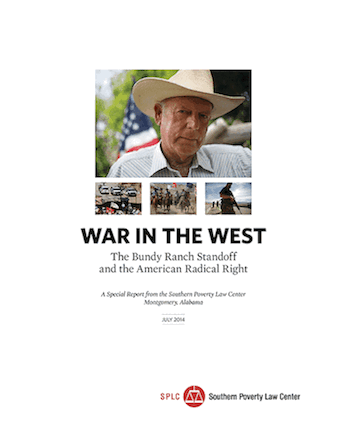DHS Report is Latest to Warn of Fallout From Bundy Ranch Standoff
A recent report by the Department of Homeland Security (DHS) finds that the April confrontation between the federal government and a Nevada rancher will likely inspire more radical antigovernment violence — the same conclusion reached earlier in a major study of the incident by the Southern Poverty Law Center.
The July DHS report, “Domestic Extremists Pose Increased Threat to Law Enforcement and Government Officials,” notes the role earlier standoffs have played. “Historically,” it said, “spikes in violence have followed high-profile confrontations involving the United States Government, such as Ruby Ridge and Waco,” a reference to deadly standoffs with extremists in Idaho and Texas in 1992 and 1993, respectively. “The April 2014 Bunkerville, Nevada standoff likely represents a similar event that could inspire further violence.”
The report was referring to the case of Cliven Bundy, a rancher who had accumulated a debt of more than $1 million in federal grazing fees that he refused to pay, calling the federal government illegitimate. When the Bureau of Land Management (BLM) finally moved to seize Bundy’s cattle based on a court order, the rancher put out a call to radical militias, many of whose members flocked to the ranch. There, a tense standoff ensued, with many militiamen pointing their weapons at federal officers, finally causing the BLM to withdraw rather than court the very real possibility of a bloodbath.
About two weeks before the July 22 DHS report was released, the Southern Poverty Law Center published a comprehensive study of the incident, “War in the West: The Bundy Ranch Standoff and the American Radical Right.” It concluded that what was seen as a Bundy victory had “invigorated” and “emboldened” the radical right, and noted that several similar confrontations had followed the Bundy standoff as a result. Parts of that study also were published in the last issue of the Intelligence Report.
The DHS report said that for “militia extremists,” the BLM climbdown was seen as a “defining victory over government oppression” that was “galvanizing some individuals … to actively confront law enforcement officials.” It cited three cases that followed the standoff: the murder of two Las Vegas police officers and another man by a couple who had been at the Bundy ranch; another person who reportedly was at the ranch who later said that militias would “exterminate” federal officials attempting a “land grab” in north Texas; and a Missouri militia group that discussed possible attacks on federal forces that might be used in some future law enforcement raid on the Bundy ranch.
Another recent law enforcement report, a New York state counterterrorism bulletin, made a similar point. The New York State Intelligence Center’s June report said that the recent killings of five police officers in the United States and Canada “highlight a trend of growing violence by far-right extremists that is likely to continue in the near term.”
That report followed a June announcement from Attorney General Eric Holder that he was re-establishing the Domestic Terrorism Executive Committee to deal with domestic extremists with motives “from anti-government animus to racial prejudice.”



